Shruti Rijhwani
ECLeKTic: a Novel Challenge Set for Evaluation of Cross-Lingual Knowledge Transfer
Feb 28, 2025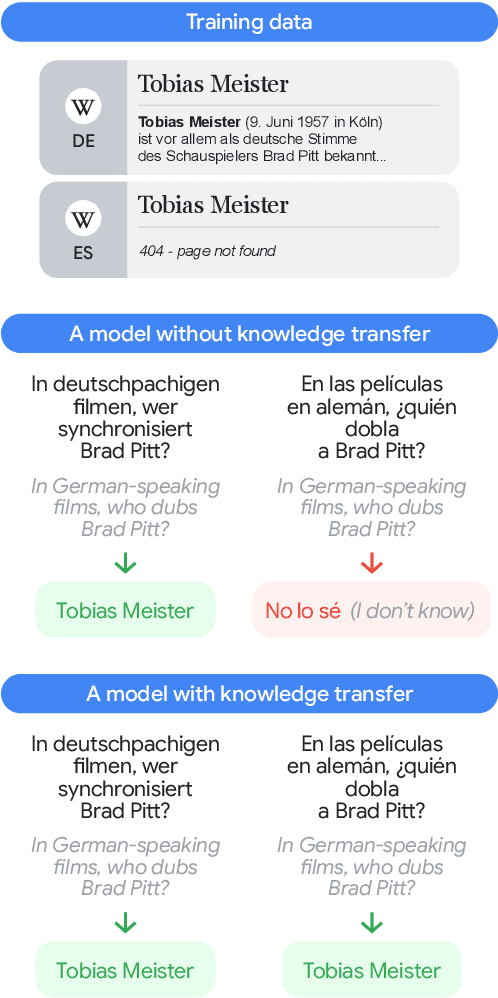
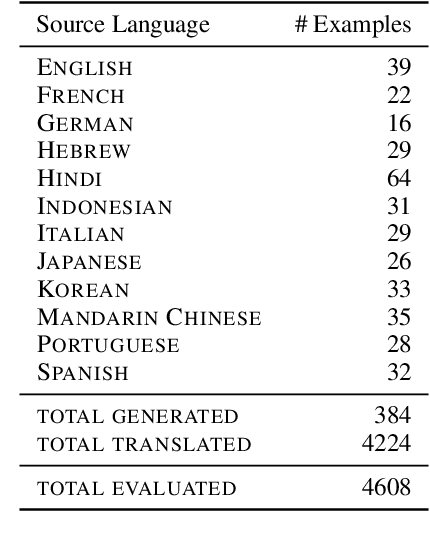
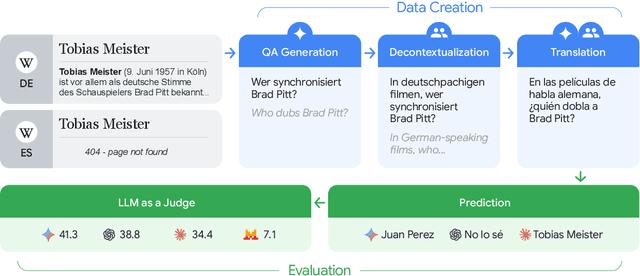
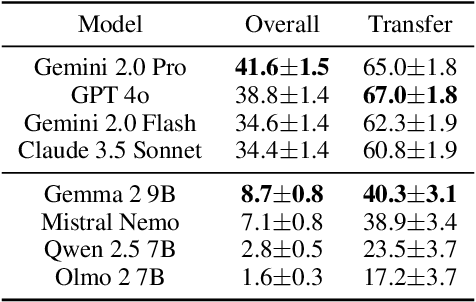
Abstract:To achieve equitable performance across languages, multilingual large language models (LLMs) must be able to abstract knowledge beyond the language in which it was acquired. However, the current literature lacks reliable ways to measure LLMs' capability of cross-lingual knowledge transfer. To that end, we present ECLeKTic, a multilingual closed-book QA (CBQA) dataset that Evaluates Cross-Lingual Knowledge Transfer in a simple, black-box manner. We detected information with uneven coverage across languages by controlling for presence and absence of Wikipedia articles in 12 languages. We generated knowledge-seeking questions in a source language, for which the answer appears in a relevant Wikipedia article and translated them to all other 11 languages, for which the respective Wikipedias lack equivalent articles. Assuming that Wikipedia reflects the prominent knowledge in the LLM's training data, to solve ECLeKTic's CBQA task the model is required to transfer knowledge between languages. Experimenting with 8 LLMs, we show that SOTA models struggle to effectively share knowledge across, languages even if they can predict the answer well for queries in the same language the knowledge was acquired in.
WMT24++: Expanding the Language Coverage of WMT24 to 55 Languages & Dialects
Feb 18, 2025Abstract:As large language models (LLM) become more and more capable in languages other than English, it is important to collect benchmark datasets in order to evaluate their multilingual performance, including on tasks like machine translation (MT). In this work, we extend the WMT24 dataset to cover 55 languages by collecting new human-written references and post-edits for 46 new languages and dialects in addition to post-edits of the references in 8 out of 9 languages in the original WMT24 dataset. The dataset covers four domains: literary, news, social, and speech. We benchmark a variety of MT providers and LLMs on the collected dataset using automatic metrics and find that LLMs are the best-performing MT systems in all 55 languages. These results should be confirmed using a human-based evaluation, which we leave for future work.
CMULAB: An Open-Source Framework for Training and Deployment of Natural Language Processing Models
Apr 03, 2024Abstract:Effectively using Natural Language Processing (NLP) tools in under-resourced languages requires a thorough understanding of the language itself, familiarity with the latest models and training methodologies, and technical expertise to deploy these models. This could present a significant obstacle for language community members and linguists to use NLP tools. This paper introduces the CMU Linguistic Annotation Backend, an open-source framework that simplifies model deployment and continuous human-in-the-loop fine-tuning of NLP models. CMULAB enables users to leverage the power of multilingual models to quickly adapt and extend existing tools for speech recognition, OCR, translation, and syntactic analysis to new languages, even with limited training data. We describe various tools and APIs that are currently available and how developers can easily add new models/functionality to the framework. Code is available at https://github.com/neulab/cmulab along with a live demo at https://cmulab.dev
Gemini: A Family of Highly Capable Multimodal Models
Dec 19, 2023Abstract:This report introduces a new family of multimodal models, Gemini, that exhibit remarkable capabilities across image, audio, video, and text understanding. The Gemini family consists of Ultra, Pro, and Nano sizes, suitable for applications ranging from complex reasoning tasks to on-device memory-constrained use-cases. Evaluation on a broad range of benchmarks shows that our most-capable Gemini Ultra model advances the state of the art in 30 of 32 of these benchmarks - notably being the first model to achieve human-expert performance on the well-studied exam benchmark MMLU, and improving the state of the art in every one of the 20 multimodal benchmarks we examined. We believe that the new capabilities of Gemini models in cross-modal reasoning and language understanding will enable a wide variety of use cases and we discuss our approach toward deploying them responsibly to users.
XTREME-UP: A User-Centric Scarce-Data Benchmark for Under-Represented Languages
May 24, 2023



Abstract:Data scarcity is a crucial issue for the development of highly multilingual NLP systems. Yet for many under-represented languages (ULs) -- languages for which NLP re-search is particularly far behind in meeting user needs -- it is feasible to annotate small amounts of data. Motivated by this, we propose XTREME-UP, a benchmark defined by: its focus on the scarce-data scenario rather than zero-shot; its focus on user-centric tasks -- tasks with broad adoption by speakers of high-resource languages; and its focus on under-represented languages where this scarce-data scenario tends to be most realistic. XTREME-UP evaluates the capabilities of language models across 88 under-represented languages over 9 key user-centric technologies including ASR, OCR, MT, and information access tasks that are of general utility. We create new datasets for OCR, autocomplete, semantic parsing, and transliteration, and build on and refine existing datasets for other tasks. XTREME-UP provides methodology for evaluating many modeling scenarios including text-only, multi-modal (vision, audio, and text),supervised parameter tuning, and in-context learning. We evaluate commonly used models on the benchmark. We release all code and scripts to train and evaluate models
SEAHORSE: A Multilingual, Multifaceted Dataset for Summarization Evaluation
May 22, 2023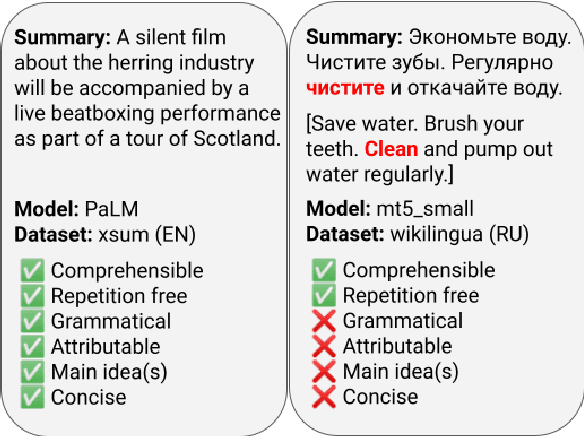
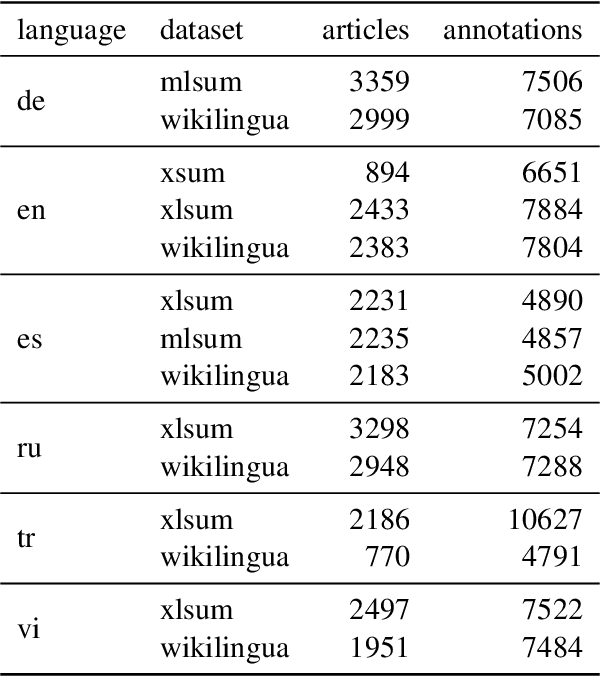
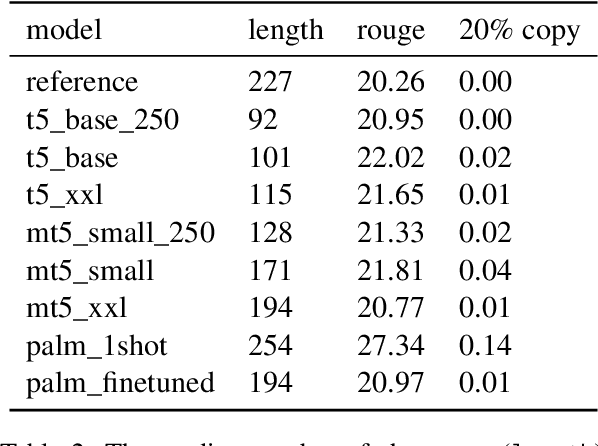
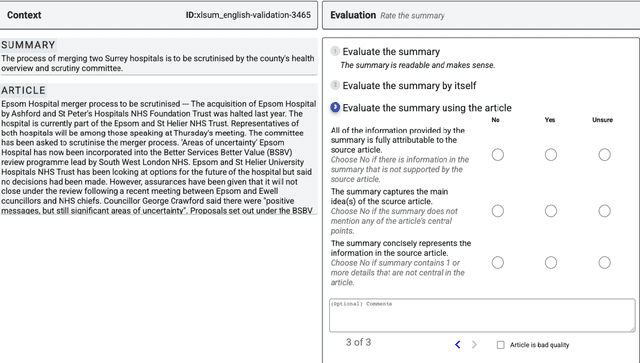
Abstract:Reliable automatic evaluation of summarization systems is challenging due to the multifaceted and subjective nature of the task. This is especially the case for languages other than English, where human evaluations are scarce. In this work, we introduce SEAHORSE, a dataset for multilingual, multifaceted summarization evaluation. SEAHORSE consists of 96K summaries with human ratings along 6 quality dimensions: comprehensibility, repetition, grammar, attribution, main ideas, and conciseness, covering 6 languages, 9 systems and 4 datasets. As a result of its size and scope, SEAHORSE can serve both as a benchmark to evaluate learnt metrics, as well as a large-scale resource for training such metrics. We show that metrics trained with SEAHORSE achieve strong performance on the out-of-domain meta-evaluation benchmarks TRUE (Honovich et al., 2022) and mFACE (Aharoni et al., 2022). We make SEAHORSE publicly available for future research on multilingual and multifaceted summarization evaluation.
User-Centric Evaluation of OCR Systems for Kwak'wala
Feb 26, 2023Abstract:There has been recent interest in improving optical character recognition (OCR) for endangered languages, particularly because a large number of documents and books in these languages are not in machine-readable formats. The performance of OCR systems is typically evaluated using automatic metrics such as character and word error rates. While error rates are useful for the comparison of different models and systems, they do not measure whether and how the transcriptions produced from OCR tools are useful to downstream users. In this paper, we present a human-centric evaluation of OCR systems, focusing on the Kwak'wala language as a case study. With a user study, we show that utilizing OCR reduces the time spent in the manual transcription of culturally valuable documents -- a task that is often undertaken by endangered language community members and researchers -- by over 50%. Our results demonstrate the potential benefits that OCR tools can have on downstream language documentation and revitalization efforts.
Lexically Aware Semi-Supervised Learning for OCR Post-Correction
Nov 04, 2021



Abstract:Much of the existing linguistic data in many languages of the world is locked away in non-digitized books and documents. Optical character recognition (OCR) can be used to produce digitized text, and previous work has demonstrated the utility of neural post-correction methods that improve the results of general-purpose OCR systems on recognition of less-well-resourced languages. However, these methods rely on manually curated post-correction data, which are relatively scarce compared to the non-annotated raw images that need to be digitized. In this paper, we present a semi-supervised learning method that makes it possible to utilize these raw images to improve performance, specifically through the use of self-training, a technique where a model is iteratively trained on its own outputs. In addition, to enforce consistency in the recognized vocabulary, we introduce a lexically-aware decoding method that augments the neural post-correction model with a count-based language model constructed from the recognized texts, implemented using weighted finite-state automata (WFSA) for efficient and effective decoding. Results on four endangered languages demonstrate the utility of the proposed method, with relative error reductions of 15-29%, where we find the combination of self-training and lexically-aware decoding essential for achieving consistent improvements. Data and code are available at https://shrutirij.github.io/ocr-el/.
Dependency Induction Through the Lens of Visual Perception
Sep 20, 2021



Abstract:Most previous work on grammar induction focuses on learning phrasal or dependency structure purely from text. However, because the signal provided by text alone is limited, recently introduced visually grounded syntax models make use of multimodal information leading to improved performance in constituency grammar induction. However, as compared to dependency grammars, constituency grammars do not provide a straightforward way to incorporate visual information without enforcing language-specific heuristics. In this paper, we propose an unsupervised grammar induction model that leverages word concreteness and a structural vision-based heuristic to jointly learn constituency-structure and dependency-structure grammars. Our experiments find that concreteness is a strong indicator for learning dependency grammars, improving the direct attachment score (DAS) by over 50\% as compared to state-of-the-art models trained on pure text. Next, we propose an extension of our model that leverages both word concreteness and visual semantic role labels in constituency and dependency parsing. Our experiments show that the proposed extension outperforms the current state-of-the-art visually grounded models in constituency parsing even with a smaller grammar size.
Evaluating the Morphosyntactic Well-formedness of Generated Texts
Mar 30, 2021



Abstract:Text generation systems are ubiquitous in natural language processing applications. However, evaluation of these systems remains a challenge, especially in multilingual settings. In this paper, we propose L'AMBRE -- a metric to evaluate the morphosyntactic well-formedness of text using its dependency parse and morphosyntactic rules of the language. We present a way to automatically extract various rules governing morphosyntax directly from dependency treebanks. To tackle the noisy outputs from text generation systems, we propose a simple methodology to train robust parsers. We show the effectiveness of our metric on the task of machine translation through a diachronic study of systems translating into morphologically-rich languages.
 Add to Chrome
Add to Chrome Add to Firefox
Add to Firefox Add to Edge
Add to Edge